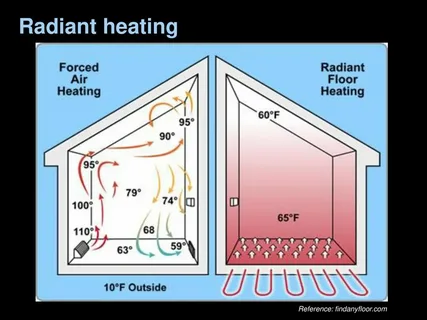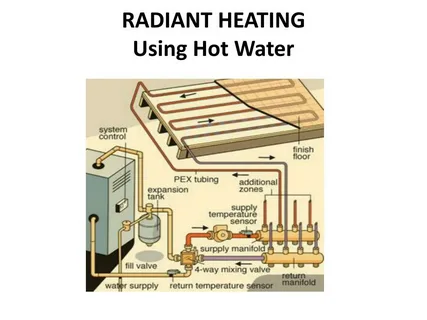Are you tired of walking on cold floors in the winter? Or constantly adjusting your thermostat to find the perfect temperature? Look no further, because radiant heat is here to solve all your heating woes. Not only is it an efficient and effective way to warm your home, but it also provides a level of comfort that traditional heating systems just can’t match. This innovative heating system is becoming increasingly popular for its ability to evenly distribute warmth throughout a space, providing a cozy and comfortable environment.
Understanding The Concept Of Radiant-Heat
Radiant-heat may sound like a complex concept, but it’s actually quite simple to understand. Unlike traditional heating systems that rely on blowing hot air into a space, radiant-heat works by transferring heat directly to the objects and surfaces in a room. This means that the heat is evenly distributed, creating a comfortable and consistent temperature throughout the space.
The key to radiant-heat lies in the use of radiant panels or pipes installed within the floor, walls, or ceiling. These panels are heated either by electricity or hot water, and they emit infrared radiation that warms up the objects and surfaces in the room. The objects, in turn, radiate heat back into the space, creating a cozy and warm environment.
One of the main advantages of radiant-heat is its ability to eliminate cold spots and drafts, which are often common with forced-air systems. With radiant-heat, you don’t have to worry about adjusting your thermostat every few minutes to maintain a comfortable temperature. The heat is constant, and you can enjoy a cozy atmosphere all year round.
 Comparing Radiant-Heat With Traditional Heating Solutions
Comparing Radiant-Heat With Traditional Heating Solutions
When it comes to heating your home, there are several options available, but how does radiant-heat compare to traditional heating solutions? Let’s take a closer look. Traditional heating systems, such as forced-air or baseboard heating, rely on blowing hot air into a room to warm it up. While these systems can provide quick heat, they often result in uneven distribution and fluctuating temperatures. This can lead to cold spots and drafts, leaving you feeling uncomfortable.
On the other hand, radiant-heat works by directly transferring heat to the objects and surfaces in a room. This means that the heat is evenly distributed, creating a consistent and comfortable temperature throughout the space. With radiant-heat, you don’t have to constantly adjust your thermostat to maintain a cozy environment.
Another advantage of radiant-heat is its energy efficiency. Traditional heating systems often lose heat through ductwork or by heating unused areas of your home. Radiant-heat, on the other hand, doesn’t experience these losses, resulting in reduced energy consumption and lower heating costs.
In terms of maintenance, radiant-heat systems require minimal upkeep compared to traditional heating systems. Radiant panels or pipes are typically durable and long-lasting, reducing the need for frequent repairs or replacements. Overall, when comparing radiant-heat with traditional heating solutions, it’s clear that radiant-heat offers a more efficient, consistent, and comfortable heating experience for your home.
Economical Perspective: Energy And Cost Efficiency Of Radiant Heat Panels
When it comes to energy efficiency and cost savings, radiant heat panels are a top contender. These panels are designed to distribute heat evenly, which not only improves comfort but also helps reduce energy consumption. Compared to traditional heating systems, radiant-heat panels have several advantages that make them an economical choice for your home.
One of the key benefits of radiant-heat panels is their energy efficiency. Unlike forced-air systems that rely on blowing hot air, radiant-heat panels transfer heat directly to the objects and surfaces in a room. This means there is minimal heat loss through ductwork or unused areas, resulting in reduced energy consumption. As a result, you can enjoy significant cost savings on your heating bills.
Additionally, radiant-heat panels offer precise temperature control, allowing you to heat specific areas of your home as needed. This targeted heating reduces the amount of energy wasted on heating unused spaces, further enhancing the cost efficiency of the system. Furthermore, radiant-heat panels have a long lifespan and require minimal maintenance. This means you can avoid the costs associated with frequent repairs or replacements, making radiant-heat a cost-effective choice in the long run.
A Greener Approach: The Environmental Impact Of Radiant-Heat
Radiant-heat not only offers comfort and cost savings, but it also provides a greener approach to heating your home. By opting for radiant-heat, you can significantly reduce your carbon footprint and minimize the environmental impact of your heating system. Unlike traditional heating solutions that rely on forced-air or baseboard heating, radiant-heat operates with a more efficient and sustainable method. By directly transferring heat to objects and surfaces, radiant-heat eliminates the need for ductwork, which can result in heat loss and wasted energy. This means less energy consumption and a reduced reliance on fossil fuels.
Additionally, radiant-heat allows for precise temperature control, allowing you to heat specific areas of your home as needed. This targeted heating further minimizes energy waste and ensures that you are only using the necessary amount of heat, making radiant-heat an eco-friendly choice. Furthermore, radiant-heat panels have a longer lifespan compared to traditional heating systems, reducing the amount of waste generated from frequent replacements. This durability contributes to a more sustainable heating solution for your home.
By choosing radiant-heat, you can enjoy a comfortable and efficient heating system while also making a positive impact on the environment. So, go ahead and embrace the greener approach with radiant-heat for a more sustainable and eco-friendly home heating solution.
The Versatility And Wide Application Of Radiant-Heat
Radiant-heat is not only efficient and cost-effective, but it is also incredibly versatile and suitable for a wide range of applications. Whether you are building a new home, remodeling an existing space, or looking to upgrade your heating system, radiant-heat is a smart choice that can meet your specific needs. One of the great advantages of radiant-heat is its flexibility in installation. Radiant panels or pipes can be installed in various locations, such as under the floor, within walls, or even in the ceiling. This means that you have the freedom to choose the best option for your home and customize the system to suit your preferences.
Additionally, radiant-heat can be used with different flooring materials, including tile, wood, carpet, and laminate. This versatility allows you to achieve the desired aesthetic for each room while enjoying the comfort and efficiency of radiant-heat. Furthermore, radiant-heat is suitable for both residential and commercial properties. Whether you have a small apartment, a large house, an office building, or a retail space, radiant-heat can provide efficient and consistent heating throughout.
Factors To Consider When Switching To Radiant-Heat
When considering a switch to radiant-heat, there are several factors to keep in mind to ensure a successful transition. First and foremost, it’s important to assess the existing heating system in your home and determine if any modifications or upgrades are needed for the installation of radiant-heat. This may involve hiring a professional to inspect your current system and make any necessary adjustments.
Another factor to consider is the cost of installation. While radiant-heat is known for its energy efficiency and cost savings in the long run, the initial installation cost can be higher compared to traditional heating systems. It’s essential to budget accordingly and weigh the long-term benefits against the upfront investment.
Additionally, you should consider the layout and design of your home. Radiant-heat is most effective when installed beneath the flooring or within the walls, so you’ll need to ensure that these areas are accessible and suitable for the installation process. If you’re remodeling or building a new home, it may be easier to incorporate radiant-heat from the beginning.
FAQs
Q: How Does Radiant Heat Compare To Traditional Heating Systems In Terms Of Comfort?
A: Radiant-heat offers superior comfort compared to traditional systems. With its even distribution of heat, you can say goodbye to cold spots and drafts, enjoying a consistently cozy temperature throughout your home.
Q: Is Radiant-Heat Energy Efficient?
A: Yes! Radiant-heat panels transfer heat directly to objects and surfaces, reducing heat loss and energy consumption. This results in cost savings on your heating bills and a greener approach to heating your home.
Q: Can Radiant Heat Be Installed In Any Home?
A: Yes! Radiant-heat is versatile and can be installed in various locations and with different flooring materials. Whether you have a small apartment or a large house, radiant-heat can provide efficient and consistent heating for your space.
Q: What Maintenance Does Radiant Heat Require?
A: Radiant-heat systems require minimal maintenance compared to traditional systems. Periodic inspections, cleaning, and occasional repairs may be necessary to ensure optimal performance.
Conclusion
From its superior comfort and even distribution of heat to its energy efficiency and cost savings, radiant-heat offers numerous benefits that traditional heating systems simply can’t match. Not only does radiant-heat provide a consistent and cozy temperature throughout your home, but it also minimizes cold spots and drafts, ensuring optimal comfort year-round.

